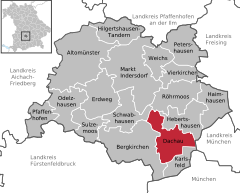Our website is made possible by displaying online advertisements to our visitors.
Please consider supporting us by disabling your ad blocker.
Dachau, Bavaria
Dachau, Bavaria | |
|---|---|
 | |
Location of Dachau, Bavaria within Dachau district  | |
| Coordinates: 48°15′37″N 11°26′3″E / 48.26028°N 11.43417°E | |
| Country | Germany |
| State | Bavaria |
| Admin. region | Oberbayern |
| District | Dachau |
| Government | |
| • Lord mayor (2020–26) | Florian Hartmann[1] (SPD) |
| Area | |
• Total | 34.85 km2 (13.46 sq mi) |
| Elevation | 483 m (1,585 ft) |
| Population (2023-12-31)[2] | |
• Total | 48,337 |
| • Density | 1,400/km2 (3,600/sq mi) |
| Time zone | UTC+01:00 (CET) |
| • Summer (DST) | UTC+02:00 (CEST) |
| Postal codes | 85221 |
| Dialling codes | 08131 |
| Vehicle registration | DAH |
| Website | http://www.dachau.de |

Dachau (German pronunciation: [ˈdaxaʊ]) is a town in the Upper Bavaria district of Bavaria, a state in the southern part of Germany. It is a major district town—a Große Kreisstadt—of the administrative region of Upper Bavaria, about 20 kilometres (12 miles) north-west of Munich. It is now a popular residential area for people working in Munich, with roughly 45,000 inhabitants. The historic centre of town with its 18th-century castle is situated on an elevation and visible over a great distance.
Dachau was founded in the 9th century. It was home to many artists during the late 19th and early 20th centuries; well-known author and editor Ludwig Thoma lived here for two years. The town is known for its proximity to the Dachau concentration camp, operated by Nazi Germany between 1933 until 1945, in which tens of thousands of prisoners died.
- ^ Liste der ersten Bürgermeister/Oberbürgermeister in kreisangehörigen Gemeinden, Bayerisches Landesamt für Statistik, accessed 19 July 2021.
- ^ Genesis Online-Datenbank des Bayerischen Landesamtes für Statistik Tabelle 12411-003r Fortschreibung des Bevölkerungsstandes: Gemeinden, Stichtag (Einwohnerzahlen auf Grundlage des Zensus 2011).
Previous Page Next Page





